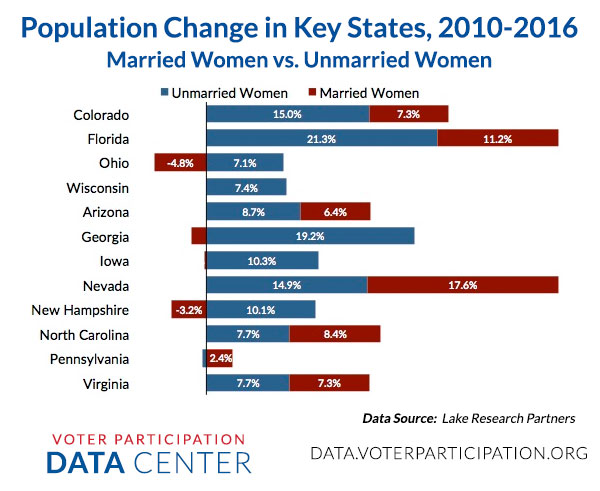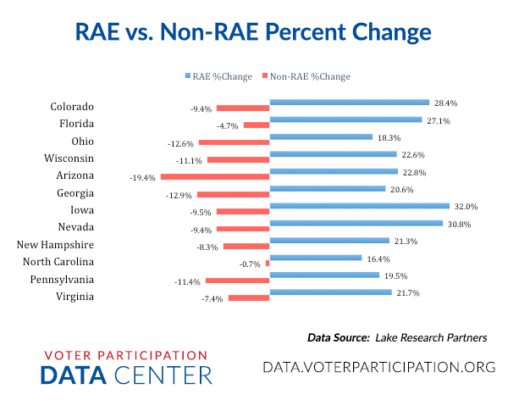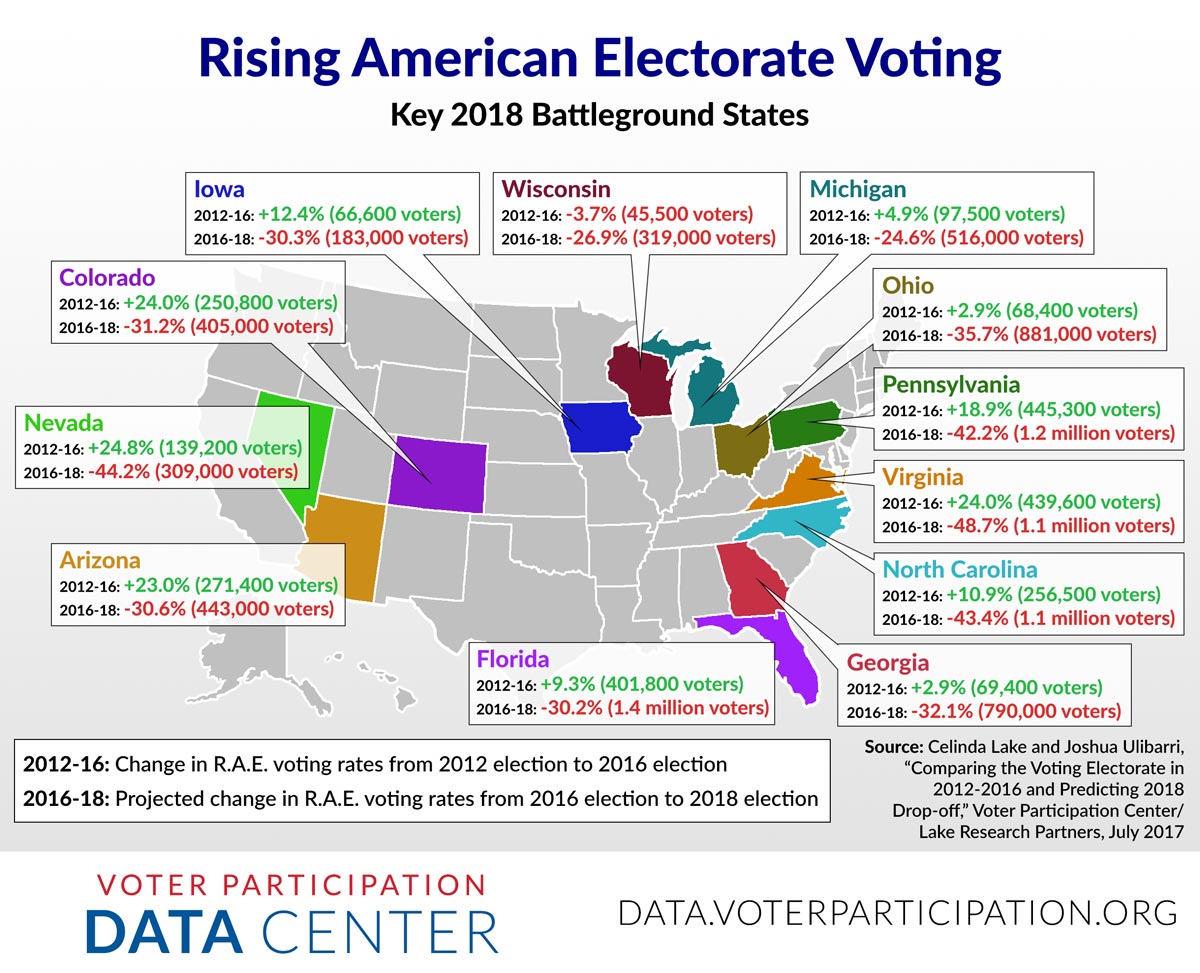Comparing the Voting Electorate in 2012-2016 and Predicting 2018 Drop-Off
As part of our ongoing efforts to understand the voting patterns of the Rising American Electorate, we’ve worked with Lake Research Partners to produce this report, which catalogues the changes in voting turnout for the Rising American Electorate between 2012 and 2016 – and makes projections for voter drop-off in 2018.
The projections are sobering and troubling to everyone who cares about increasing participation in our great democracy. Our prediction is that 40 million Americans who voted in 2016 won’t cast a ballot in the 2018 midterms — and to make matters worse, 2/3 of those drop-off voters will be members of the Rising American Electorate. The RAE dropoff is projected to be particularly pronounced in key 2018 battleground states, such as Arizona, Nevada, Florida, and Ohio:
Add in the effects of ongoing vote suppression efforts and the implication is clear: Democracy is facing a headwind in 2018. We need to double down on voter registration, mobilization and turnout efforts, and fighting for voting rights in order to make sure that every American has the opportunity to raise their voice at the ballot box.
Downloads
Unmarried Women: Growing in Numbers and the Power to Decide 2016 Elections
There are more than 58 million single women eligible to vote this November. For the first time ever, there are more single women than married women eligible to vote, and their numbers continue to grow nationally and in key states. And as the new poll of nine battleground states conducted for Women’s Voices Women Vote Action Fund shows, single women could determine the outcome of the presidential election and U.S. Senate races down-ballot.

Chart: Rising American Electorate vs. Non-RAE Percent Change
This chart showing the growth of the Rising American Electorate – unmarried women, people of color, and Millennials – in key states between 2010 and 2016 demonstrates quite clearly how broadly and quickly the face of America is changing.

All information was provided by Lake Research Partners.
The Rising American Electorate in South Carolina and Nevada
The stories out of Iowa and New Hampshire focused on the participation levels, voting preferences, and burgeoning political power of millennial voters. But as the presidential contests move west to Nevada and south to South Carolina, the electorates begin to look more like the national body of voters. The coming contests will be more accurate tests of the power and influence of young voters and the rest of the Rising American Electorate (RAE).
Nationally, the RAE—which is comprised of millennials (voters 35 and younger), unmarried women, and people of color—make up the majority, close to 57 percent, of all eligible voters.
In South Carolina, that combination of voters makes up exactly 57 percent of the vote-eligible population:
- Unmarried women make up 27 percent of eligible voters;
- Millennials make up 27 percent; and
- African-Americans make up 26 percent.
And what’s the overlap between these demographic groups?
- 38.7 percent of all millennials in South Carolina are unmarried women;
- 32.6 percent of eligible African-American voters are 35 or younger; and
- 31.7 percent of millennials in the state are unmarried African-American women.
In Nevada, the RAE accounts for 62 percent of eligible voters, meaning their influence over the caucus outcomes could be significant.
- Unmarried women make up 26 percent of eligible voters;
- Millennials make up 28 percent; and
- Latinos account for 19 percent of all eligible voters in the state.
The overlap?
- 26.5 percent of voters 35 and younger (millennials) in Nevada are unmarried women.
- 27.6 percent of millennials are Latino; and,
- 16.5 percent of millennials are unmarried Latina women.
2016 Primary Spotlight: South Carolina and Nevada
The voices of more racially-diverse Presidential voters will be heard starting Feb. 20, 23, and 27 with the South Carolina primaries and Nevada caucuses. For the first time this primary season, the Rising American Electorate (RAE)—the population of unmarried women, people of color, and millennials—in South Carolina and Nevada make up the overwhelming majority of eligible voters, just as they do nationally.
The RAE makes up close to 57 (56.7%) percent of eligible voters in U.S. In Iowa, the RAE made up 45 percent of eligible voters and just 41 percent in New Hampshire. But in South Carolina, the RAE makes up 57 percent of eligible voters in the state; they make up 62 percent in Nevada.
South Carolina
The South Carolina primaries are the “first in the South” primaries for both parties. The Republican primary will be held on February 20; the Democrats will vote on February 27. Historically, these key early primaries have helped narrow the field of both Democratic and Republican contenders. The state does not have registration by party. Voters may vote in either party’s primary, but not in both.
South Carolina’s primary is the first contest in which a large percentage of the electorate will be African American. People of color make up 31 percent of the eligible voters in South Carolina. 65 percent of those eligible voters are registered to vote; 35 percent are not.
Unmarried women in South Carolina make up 27 percent of the eligible voters:
- Women make up more than half of South Carolina’s population (53%)
- There are more unmarried women (51.3%) than married women (48.7%) in the state.
- 5 percent of unmarried women in South Carolina are African-American.
- 64 percent of unmarried women are registered to vote.
A detailed demographic analysis from the Voter Participation Data Center shows that unmarried women have a large and vital economic stake in the outcome of the presidential election:
- Unmarried women have the highest unemployment rate in the state: 9.9%. They are more than two and a half times more likely to be unemployed than married women (3.7%).
- Unmarried women earn less than married women. Married women in South Carolina earn close to what a man earns (93.8%); unmarried women lag behind making 81.4 percent of what a man earns in the Palmetto State.
- More than a quarter of unmarried women in South Carolina live in poverty and unmarried women are more than 3 times as likely to live in poverty (25.8%) than married women (8.0%).
- About six in ten of all minimum wage or below-minimum wage workers in South Carolina are women.
Nevada
Nevada’s Democratic caucus is scheduled for February 20; the GOP caucus is set for February 23. Nevada is the first state in the West to vote, the first primarily labor-based state to vote, and the first state with a significant Hispanic population to vote. Close to one in five (18.9%) of Nevada’s eligible voters is Hispanic. Fifty-four percent of eligible Hispanic voters in Nevada are registered to vote; 46 percent are not.
Anyone who will be 18 years old at the time of the Nov. 8 general election is eligible to participate in the caucuses, including high school students. The caucus is a partisan process; people who want to participate must be registered as a member of the party. Democrats have same-day registration while Republicans require voters to register by Feb. 13.
Unmarried women make up 26 percent of Nevada’s eligible voters.
- There are close to equal numbers of men and women in Nevada. Women make up 50.3% of Nevada’s population; men make up 49.7%.
- There are more unmarried women (51.6%) than married women (48.4%) in the state.
- More than a quarter of Hispanics are unmarried women (25.6%).
- 55 percent of unmarried women are registered to vote.
An economic profile from the Voter Participation Data Center makes it clear unmarried women have a lot riding on the outcome of the presidential election:
- Unmarried women have the highest unemployment rate in the state (11.5%). They are more than four times more likely to be unemployed than married women (2.6%)
- Unmarried women earn less than married women. Married women in Nevada earn 82.5% of what a man earns; unmarried women make 76.8% of what a man earns in the Palmetto State.
- More than a fifth of unmarried women in Nevada live in poverty and unmarried women are more than almost 3 times as likely to live in poverty (21.3%) than married women (7.7%).
Next: Super Tuesday, March 1
New Data for the New Year
Here’s an updated look at the median earnings, health insurance coverage and poverty rates for unmarried women in 16 states. These profiles provide detailed demographic and economic portraits of the growing number of increasingly politically-powerful single women.
| California Colorado Florida Illinois |
Iowa Kentucky Missouri Nevada |
New Hampshire New York North Carolina Ohio |
Pennsylvania Texas Virginia Wisconsin |
Unmarried Women: The Key to Unlocking the New American Electorate
An astonishing number of single women aren’t yet registered to vote. If we help even a small percentage more of unmarried women register and vote, we’d likely see different results up and down the ballot in key 2016 states.
(Click on a state name in the table to view our demographic profile of unmarried women for that state.)
| State | Unmarried Women | % of Vote-Eligible Population | Registered to Vote | Not Registered to Vote |
| Colorado | 830,224 | 22% | 546,725 (66%) | 283,499 (34%) |
| Florida | 3,637,949 | 26% | 2,184,986 (60%) | 1,452,963 (40%) |
| Iowa | 524,096 | 23% | 325,929 (62%) | 198,167 (38%) |
| Missouri | 1,010,097 | 23% | 665,390 (66%) | 344,707 (34%) |
| Nevada | 482,278 | 26% | 266,875 (55%) | 215,404 (45%) |
| New Hampshire | 239,332 | 24% | 146,705 (61%) | 92,627 (39%) |
| North Carolina | 1,803,826 | 26% | 1,147,794 (64%) | 656,032 (36%) |
| Ohio | 2,171,933 | 26% | 1,341,439 (62%) | 830,495 (38%) |
| Pennsylvania | 2,296,628 | 24% | 1,404,064 (61%) | 892,563 (39%) |
| Virginia | 1,399,995 | 24% | 831,891 (59%) | 568,104 (41%) |
| Wisconsin | 1,007,304 | 24% | 637,094 (63%) | 370,210 (37%) |
Data Source: Current Population Survey: Voting and Registration Supplement, 2014. U.S. Department of Commerce, Bureau of the Census.
Statistical Profile of Unmarried Women: Nevada
Our research team has compiled available data from the US Census Bureau, the Bureau of Labor Statistics, and other sources to put together this statistical profile of the demographic and economic circumstances facing unmarried women in the state of Nevada.
Report updated May 2017


